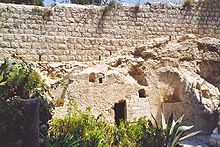Garden grave
The garden tomb is an ancient burial place in Jerusalem , which is believed by some Anglican and free church Christians to be the tomb of Jesus .
location
The garden tomb is located north of the Damascus Gate just outside the old city of Jerusalem . The burial chamber from Roman times was carved out of a rock wall several meters high. Today it is surrounded by well-tended gardens, which many visitors to Jerusalem appreciate as a place of rest and reflection in the busy city.
history
The garden grave was discovered in 1867. The year 1883 was decisive for the further development, when the English Major General Charles Gordon came to the conclusion that the garden grave must be the tomb of Jesus. The location in front of the city wall and the shape of the hill or rock, which looks like a skull from different sides, served as evidence. Since the name " Golgotha " can be derived from the Aramaic word Gûlgoltâ ("skull"), Gordon concluded that this must be the place from which the Gospels tell ( Mt 27.33 EU ; Mk 15.22 EU ; Jn 19, 17 EU ). This interpretation had already been suggested by Claude Reignier Conder (1870) and Fisher Howe (1871). The connection of Golgotha (Γολγοθα) with Hebrew Gulgolet or aram. Gûlgoltâ was brought into play by the German scholar Otto Thenius as early as 1842.
The grave was excavated in 1891, and in 1894 the "Garden Grave Association" was founded to preserve the site and bought the area around the grave with donations.
authenticity
It is generally assumed by archaeologists today that the garden grave is not the tomb of Jesus. This is how Bargil Pixner judged :
- "The so-called garden tomb on Nablus Road north of the Damascus Gate is an attractive place for meditation and prayer, but for archaeological and historical reasons it is out of the question as a site of the crucifixion and burial of Jesus."
The vast majority of archaeologists consider the Church of the Holy Sepulcher to be plausible as the place of Jesus' burial. Pixner (1991) already considered this to be “scientifically well founded”. The location is supported by the early testimonies of pilgrims, the construction of the basilica by Constantine the Great and archaeological evidence.
Much earlier seemed to speak for the authenticity of the grave: Christian symbols inside the grave and the fact that the place was traditionally referred to as the “stoning place”. The main argument, however, was that Jesus was “led out” of the city for the crucifixion ( Mt 27,32 EU ), while the Church of the Holy Sepulcher is within the (today's) city walls. This argument is considered refuted. In the meantime it is archaeologically proven that the hill on which the Church of the Holy Sepulcher stands was outside the city walls at the time of Jesus. As an undeveloped quarry, it was an “ideal place” for the construction of a rock grave.
literature
- Max Küchler : Jerusalem: A Handbook and Study Guide to the Holy City (Places and Landscapes of the Bible, Volume IV.2). 2nd, completely revised edition, Vandenhoeck & Ruprecht, Göttingen 2014, pp. 347–351.
- Shimon Gibson: The Seven Last Days of Jesus. The archaeological facts. dtv , Munich 2012 (Orig .: The Final Days of Jesus. The Archaeological Evidence. 2009). In it on the place of the crucifixion and burial: pp. 136–185, especially on the garden grave: p. 148, p. 170 f.).
- Sarah Kochav: The Search for a Protestant Holy Sepulcher: The Garden Tomb in Nineteenth-Century Jerusalem. In: The Journal of Ecclesiastical History , Volume 46, Issue 2 (April 1995), pp. 278-301, doi : 10.1017 / S0022046900011374 .
Web links
Individual evidence
- ↑ Bargil Pixner : Ways of the Messiah and sites of the early church , Giessen and Basel 1991, pp. 275–280. Quote: p. 275.
- ↑ Max Küchler: Jerusalem: A manual and study travel guide to the Holy City. 2nd ed., Göttingen 2014, pp. 287-300.
- ↑ Bargil Pixner: Ways of the Messiah and sites of the early church , Giessen and Basel 1991, p. 276.
- ^ Katharina Galor, Hanswulf Bloedhorn: The Archeology of Jerusalem. From the Origins to the Ottomans. Yale University Press, New Haven / London 2013, p. 71 and Note 27.
- ↑ Shimon Gibson: The seven last days of Jesus. Munich 2012, p. 150; see. P. 171.
Coordinates: 31 ° 47 ′ 2.4 ″ N , 35 ° 13 ′ 48 ″ E

